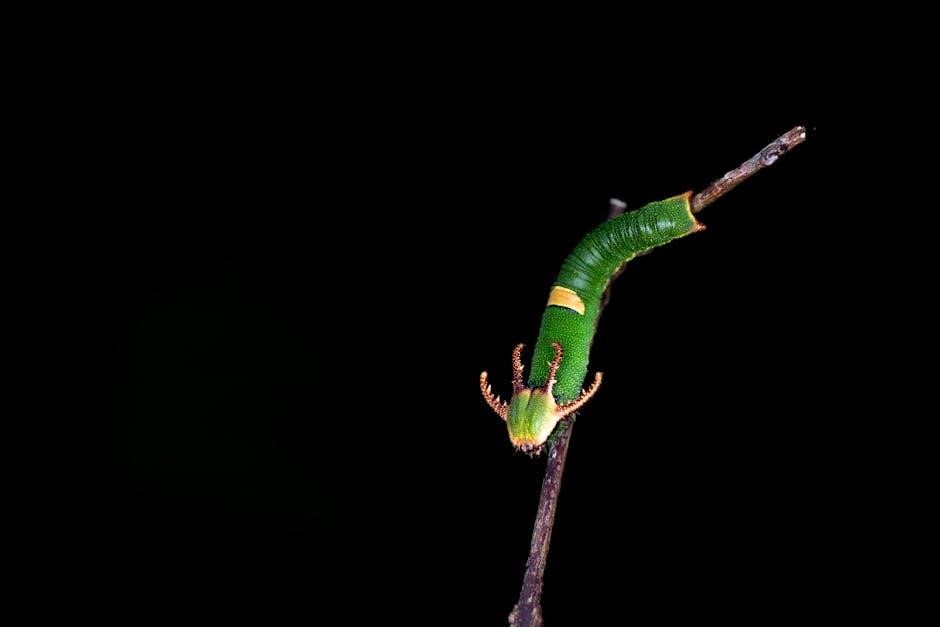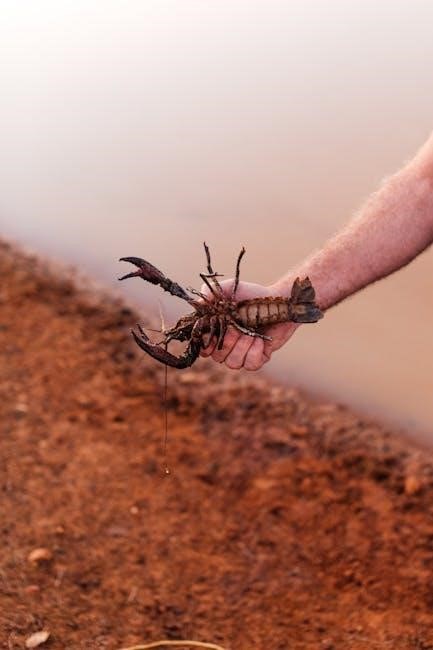Ecology is the scientific study of interactions between organisms and their environment, exploring biodiversity, ecosystems, and environmental impacts; Study guides provide essential tools for understanding these concepts.

1.1 Definition and Scope of Ecology
Ecology is the scientific study of interactions between organisms and their environment, focusing on biotic (living) and abiotic (non-living) factors. It examines how organisms adapt, survive, and interact within ecosystems. The scope of ecology spans from individual organisms to entire ecosystems, addressing questions about population dynamics, community structures, and environmental impacts. It integrates biology, chemistry, and physics to understand the natural world and human influences on it.
- Explores relationships within ecosystems.
- Covers organism, population, community, and ecosystem levels.
- Applies to conservation, resource management, and sustainability.
1.2 Importance of Studying Ecology
Studying ecology is crucial for understanding the natural world and our role within it. It helps address environmental challenges like climate change, conservation, and resource management. Ecology provides insights into how ecosystems function, supporting biodiversity and human well-being; By studying ecology, we can develop sustainable practices, mitigate human impacts, and preserve ecosystems for future generations. It is essential for informed decision-making and promoting environmental stewardship.
- Understands ecosystem functioning and biodiversity.
- Addresses climate change and conservation.
- Guides sustainable resource management.

Key Concepts in Ecology
Key concepts in ecology include understanding ecosystems, biodiversity, and interactions between organisms and their environment. Study guides provide essential resources for grasping these fundamental ecological principles effectively.
2.1 Biotic and Abiotic Factors
Biotic factors are living components in an ecosystem, such as plants, animals, and microbes. Abiotic factors are non-living elements, including water, temperature, light, and soil. Both interact to shape the ecosystem’s balance and dynamics. Understanding these factors is crucial for analyzing how organisms adapt and survive in their environment. Study guides often emphasize these distinctions to help students grasp ecological interactions effectively.
2.2 Habitat and Niche
Habitat refers to the physical environment where an organism lives, including factors like soil, water, and shelter. A niche describes the specific role and resources an organism uses within its habitat; While multiple species can share a habitat, each occupies a unique niche to avoid competition. Study guides highlight these concepts to illustrate how species coexist and adapt within ecosystems, ensuring ecological balance and diversity.
2.3 Levels of Ecological Study: Organism, Population, Community, Ecosystem
Ecology is studied at four main levels: organism, population, community, and ecosystem. The organism level focuses on individual species and their adaptations. A population consists of all individuals of a species in a specific area. A community includes all populations of different species interacting within a habitat. An ecosystem encompasses both biotic (living) and abiotic (non-living) components, illustrating the interconnectedness of life and the environment. Study guides emphasize these levels to provide a structured understanding of ecological systems.
Ecosystems
Ecosystems are complex networks of biotic and abiotic components, functioning together to maintain balance and support life. They are vital for understanding ecological processes and sustainability.
3.1 Structure of Ecosystems

An ecosystem’s structure includes biotic (living) and abiotic (non-living) components. Biotic factors are producers, consumers, and decomposers, while abiotic factors include light, temperature, water, and nutrients. Energy flows through ecosystems via food chains and webs, while nutrients cycle through biogeochemical processes. This structure supports interactions that sustain life and maintain ecological balance, essential for understanding how ecosystems function and respond to environmental changes.
3.2 Types of Ecosystems: Terrestrial and Aquatic
Terrestrial ecosystems include forests, grasslands, and deserts, while aquatic ecosystems encompass freshwater (rivers, lakes) and marine (oceans, coral reefs) environments. Terrestrial ecosystems rely on soil and sunlight, supporting diverse plant and animal life. Aquatic ecosystems are water-based, with organisms adapted to varying depths and salinity levels. Both types play crucial roles in global biodiversity and ecological balance, providing habitats for countless species and regulating Earth’s climate and nutrient cycles.
3.3 Ecosystem Services and Their Significance
Ecosystem services are essential for human well-being and environmental balance. They include provisioning services like food and water, regulating services such as climate control, cultural services for recreation, and supporting services like nutrient cycling. These services sustain life, enhance biodiversity, and maintain ecological balance, making them vital for addressing global challenges and ensuring sustainable development.
Population Dynamics
Population dynamics study growth patterns, limiting factors, and life strategies, essential for understanding species survival, ecosystem balance, and environmental interactions.
4.1 Population Growth Patterns
Population growth patterns describe how species numbers change over time. Exponential growth occurs in ideal conditions with unlimited resources, while logistic growth slows as populations approach carrying capacity. Factors like food availability, predators, and environmental changes influence these patterns; Understanding growth curves is crucial for managing ecosystems and predicting species responses to environmental changes, as outlined in ecology study guides.
4.2 Limiting Factors: Density-Dependent and Density-Independent
Limiting factors regulate population growth by restricting resource availability. Density-dependent factors, such as predators, disease, and competition, intensify as population density increases. Density-independent factors, like natural disasters or resource scarcity, affect populations regardless of size. Both types influence population dynamics, shaping growth patterns and stabilizing ecosystems. Understanding these factors is key to predicting population trends and managing ecological balance, as detailed in ecology study guides.
4.3 Life History Strategies
Life history strategies refer to the traits and characteristics that influence an organism’s survival, growth, and reproduction. These strategies, such as age of reproduction, number of offspring, and lifespan, are shaped by environmental pressures. Organisms adapt to maximize their fitness, ensuring species survival. Study guides highlight how these strategies vary across species, emphasizing their role in population dynamics and ecological balance, providing insights into evolutionary adaptations and biodiversity.

Community Interactions
Community interactions involve relationships among species, such as symbiosis, predation, and competition, shaping ecosystem dynamics and biodiversity. Study guides detail these interactions, enhancing ecological understanding.
5.1 Symbiosis: Mutualism, Commensalism, Parasitism
Symbiosis describes persistent relationships between species. Mutualism benefits both, like clownfish and sea anemones. Commensalism aids one without harming the other, such as remora fish with sharks. Parasitism harms the host, as tapeworms do. These interactions shape biodiversity and ecosystem balance, as detailed in study guides for ecological understanding.
5.2 Predation and Prey Relationships
Predation involves one organism hunting another for food, shaping ecosystem dynamics. Prey evolves defenses like camouflage or mimicry, while predators develop strategies to catch them. These interactions influence population sizes, behavior, and energy flow. Study guides highlight examples, such as predator-prey cycles, to illustrate how these relationships maintain ecological balance and biodiversity, ensuring survival in diverse environments.
5.3 Competition and Coexistence
Competition occurs when species vie for shared resources, shaping community dynamics. Coexistence is achieved through mechanisms like resource partitioning or niche differentiation. Study guides explain how species adapt to reduce competition, ensuring survival. These interactions influence biodiversity and ecosystem stability, highlighting the balance between rivalry and cooperation in nature.

Ecological Succession
Ecological succession is the process of ecosystem change over time, involving the replacement of species. It occurs in both primary and secondary forms, shaping biodiversity.
6.1 Types of Succession: Primary and Secondary
Primary succession occurs in lifeless areas, like volcanic rock, where soil and organisms develop from scratch. Secondary succession happens in areas with existing soil, such as after fires, where plant seeds or roots remain. Both processes involve gradual changes in species composition, leading to a stable ecosystem over time. Understanding these types helps in grasping how ecosystems recover and evolve naturally.
6.2 Factors Influencing Succession
Succession is influenced by climate, soil, topography, and human activities. Climate determines the types of species that can thrive, while soil quality affects nutrient availability. Topography influences water and sunlight distribution, shaping plant growth. Human actions, such as deforestation or fire, can accelerate or alter succession pathways. These factors collectively determine the rate and direction of ecosystem development, leading to diverse plant communities over time.
Energy Flow in Ecosystems
Energy flows through ecosystems via food chains and webs, starting with producers who capture sunlight. Consumers transfer energy between trophic levels, while decomposers recycle it back.
7.1 Food Chains and Food Webs
A food chain outlines the sequence of energy transfer from producers to consumers, while a food web represents multiple interconnected chains. Producers, like plants, form the base, transferring energy to herbivores and carnivores. Decomposers recycle nutrients back into ecosystems. Energy transfer efficiency is typically low, with only 10% passing to the next trophic level. Food webs provide a comprehensive view of ecosystem interactions, highlighting biodiversity and ecological balance.
7.2 Trophic Levels and Energy Pyramids
Trophic levels represent the feeding positions of organisms in an ecosystem, starting with producers at the base. Energy pyramids illustrate the decreasing energy availability at each level, as only 10% of energy transfers to the next trophic level. Producers, primary consumers, and secondary consumers form the hierarchy. This structure highlights energy flow efficiency and the importance of lower trophic levels in sustaining ecosystems, emphasizing the foundational role of producers.
7.3 Efficiency of Energy Transfer
Energy transfer between trophic levels is inefficient, with only about 10% of energy passing to the next level. This is due to factors like respiration, digestion, and energy lost as heat. Producers capture the most energy, while higher trophic levels receive progressively less. Understanding this inefficiency helps explain ecosystem dynamics and the importance of maintaining balanced energy flows to support biodiversity and ecological stability.

Biogeochemical Cycles
Biogeochemical cycles involve the movement of nutrients like carbon, water, nitrogen, and phosphorus through ecosystems. These cycles sustain life by recycling essential elements between living organisms and the environment.
8.1 Carbon Cycle
The carbon cycle describes the movement of carbon through ecosystems. It involves processes like photosynthesis, respiration, decomposition, and fossil fuel combustion. Carbon is stored in sinks such as oceans, forests, and soil. Human activities, particularly burning fossil fuels, have disrupted the cycle, leading to increased atmospheric CO2 levels and climate change. Understanding this cycle is crucial for addressing global environmental challenges.
8.2 Water Cycle
The water cycle, or hydrologic cycle, describes the continuous movement of water on, above, and below Earth’s surface. It involves evaporation, condensation, precipitation, and collection. Water evaporates from oceans, lakes, and plants, forming clouds. Precipitation returns water to land, replenishing ecosystems and sustaining life. Human activities, such as deforestation and pollution, can disrupt this cycle, affecting water availability and quality. Understanding the water cycle is vital for managing resources and addressing environmental challenges.
8.3 Nitrogen Cycle

The nitrogen cycle is a vital biogeochemical process that converts nitrogen into forms usable by living organisms. It involves nitrogen fixation, where bacteria convert atmospheric nitrogen into ammonia, nitrification, where ammonia is oxidized into nitrates, and denitrification, returning nitrogen to the atmosphere. Microorganisms play a key role in these processes. Human activities, such as fertilizer use, can disrupt the cycle, leading to environmental issues like water pollution. Understanding the nitrogen cycle is essential for sustainable ecosystem management.
8.4 Phosphorus Cycle
The phosphorus cycle involves the movement of phosphorus through ecosystems, primarily in rock, soil, water, and living organisms. Unlike nitrogen, phosphorus doesn’t cycle through the atmosphere. It is released through weathering of rocks and decomposition of organic matter. Microorganisms play a role in converting phosphorus into usable forms. Human activities, such as fertilizer use, can disrupt the cycle, leading to nutrient runoff and water pollution. Understanding the phosphorus cycle is crucial for managing agricultural and aquatic ecosystems sustainably.
Human Impact on Ecosystems
Human activities like habitat destruction, pollution, and climate change significantly disrupt ecosystems, threatening biodiversity and altering ecological balance, as highlighted in ecology study guides.
9.1 Habitat Destruction and Fragmentation
Habitat destruction and fragmentation disrupt ecosystems, leading to population decline and species isolation. Human activities like deforestation and urbanization cause loss of natural habitats, reducing biodiversity. Fragmentation isolates species, affecting their ability to adapt and survive. Study guides emphasize these impacts, highlighting the need for conservation strategies to mitigate habitat loss and preserve ecological balance for future generations.
9.2 Pollution: Types and Effects
Pollution, including air, water, and land contamination, disrupts ecosystems and threatens biodiversity. Chemical pollutants like pesticides and heavy metals harm organisms, while greenhouse gases contribute to climate change. Study guides detail how pollution affects species survival, reproduction, and ecosystem services, emphasizing the need for sustainable practices to mitigate these impacts and protect environmental health.
9.3 Climate Change and Its Ecological Consequences
Climate change, driven by rising greenhouse gases, alters ecosystems globally. It causes temperature increases, extreme weather, and disrupted species habitats. Polar ice melting and coral bleaching exemplify its impacts. Ecosystems face biodiversity loss, while food chains are destabilized. Conservation efforts are critical to mitigate these effects and protect vulnerable species from extinction, ensuring ecological balance and sustainability for future generations.
Conservation Biology
Conservation biology focuses on protecting biodiversity through strategies like habitat restoration and species protection. It addresses threats such as habitat loss and climate change, ensuring ecosystem sustainability.
10.1 Principles of Conservation

Conservation biology is rooted in preserving biodiversity and ecosystem integrity. Key principles include protecting habitats, restoring degraded areas, and promoting sustainable practices. It emphasizes the importance of maintaining genetic diversity, preventing extinction, and addressing human impacts on ecosystems. Conservation strategies often involve collaboration between scientists, policymakers, and communities to ensure long-term environmental health and resilience. These principles guide efforts to protect endangered species and restore ecosystems, ensuring a balanced and thriving natural world for future generations.
10.2 Strategies for Biodiversity Preservation
Effective biodiversity preservation involves protecting and restoring habitats, promoting sustainable practices, and engaging communities. Strategies include establishing protected areas, combating invasive species, and addressing climate change impacts. Conservation efforts also focus on sustainable resource use, reducing pollution, and promoting coexistence with wildlife. Education and community involvement are crucial for long-term success, ensuring that biodiversity preservation aligns with human needs while maintaining ecosystem balance and resilience for future generations.
10.3 Case Studies in Conservation Success
Conservation success stories highlight effective strategies, such as the recovery of bald eagles through pesticide regulation and habitat protection. Reintroduction programs, like gray wolf restoration, demonstrate species revival. Community-led initiatives, such as coral reef preservation, showcase local engagement. These cases emphasize the importance of targeted actions, policy enforcement, and public participation in achieving biodiversity goals and ecological balance, offering valuable lessons for future conservation efforts.
Tools and Methods in Ecology
Ecology employs various tools and methods, including field observations, experiments, and laboratory analysis. Remote sensing and GIS technologies enhance data collection and interpretation, aiding ecological research and management effectively.
11.1 Field Observations and Experiments
Field observations and experiments are crucial in ecology for collecting data on ecosystems and species. Tools like quadrats and sensors are used to measure population sizes and environmental factors. These methods allow ecologists to study interactions and patterns in natural settings. Study guides provide detailed answers and explanations for such fieldwork, helping students verify their findings and deepen their understanding of ecological principles and practices.
11.2 Laboratory Analysis and Data Interpretation
Laboratory analysis in ecology involves processing field data to draw meaningful conclusions. Techniques like microscopy and spectrophotometry help analyze samples. Data interpretation uses statistical methods to identify patterns and trends. Study guides provide detailed answers, explaining how to apply these tools and interpret results effectively. This step is crucial for understanding ecological processes and validating field observations, ensuring accurate and reliable conclusions in ecological studies.
11.3 Remote Sensing and GIS in Ecology
Remote sensing and GIS are powerful tools in ecology for analyzing spatial data. Satellites and drones collect data on land use, deforestation, and habitat changes. GIS maps and analyzes this data to understand ecological patterns. Study guides explain how these technologies aid in conservation planning, species tracking, and climate change research. They enable ecologists to visualize and manage large-scale environmental data effectively, supporting informed decision-making and sustainable practices.

The ecology study guide answer key summarizes key concepts, reinforcing understanding of ecosystems, biodiversity, and environmental interactions. It provides clear solutions, aiding students in mastering ecological principles effectively;
12.1 Summary of Key Concepts
The ecology study guide answer key encapsulates fundamental concepts, including ecosystems, biodiversity, and environmental interactions. It reinforces understanding of population dynamics, ecological succession, and energy flow, while emphasizing conservation principles. Detailed explanations and practical examples ensure comprehensive learning, aiding students in mastering ecological principles and their real-world applications effectively.
12.2 The Role of Ecology in Addressing Global Challenges
Ecology plays a vital role in addressing global challenges such as climate change, biodiversity loss, and environmental sustainability. By understanding ecosystem dynamics, conservation strategies, and human impacts, ecological principles guide effective solutions. The study guide answer key equips students with knowledge to tackle these issues, emphasizing the importance of sustainable practices and informed decision-making for a healthier planet and future generations.

Write Reviews
Leave a Comment
No Comments & Reviews